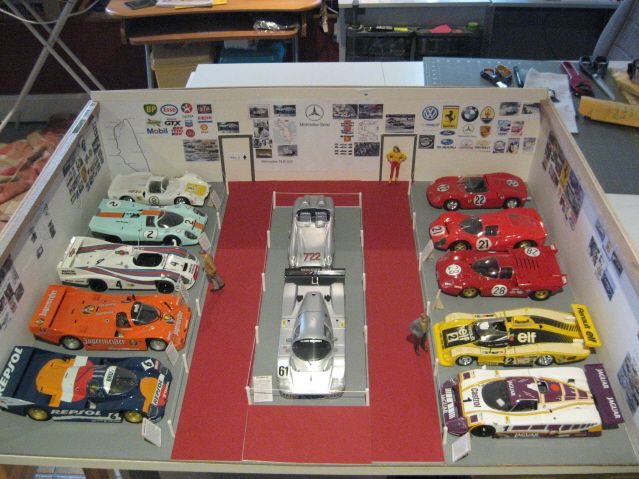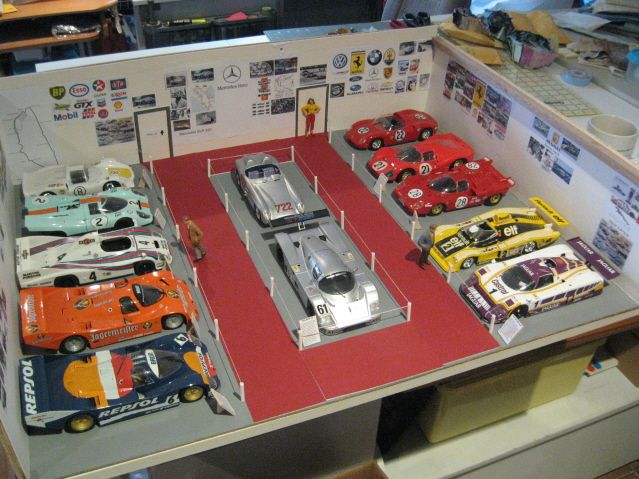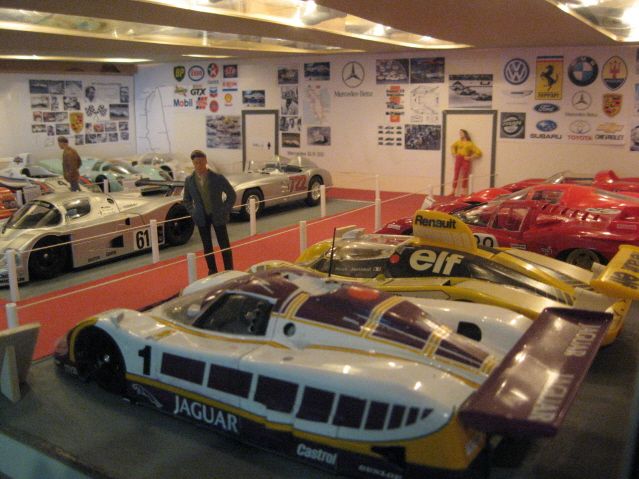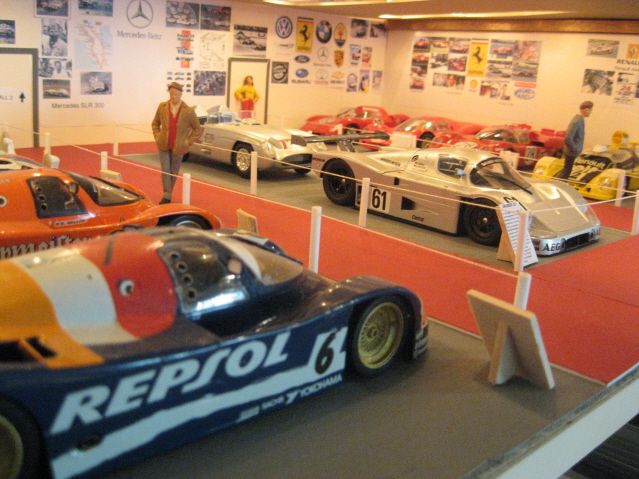Post by Deleted on Aug 18, 2012 2:45:22 GMT -5
Gents - all but one car done - you can see the gap it will fill:

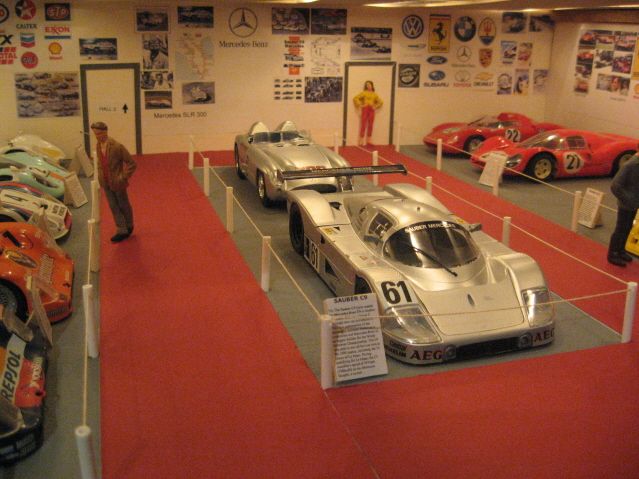
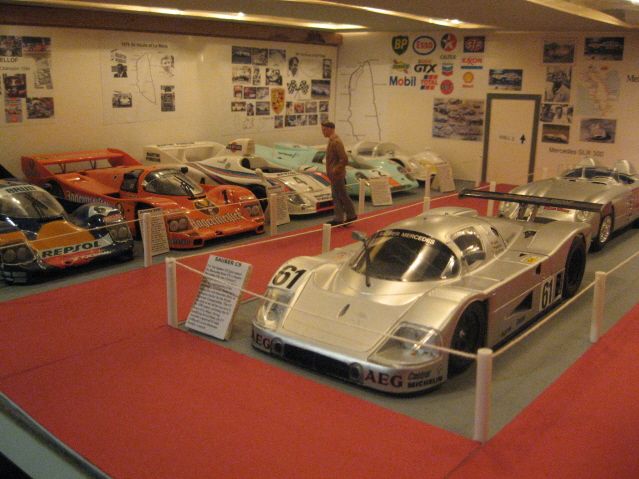

Porsche 906:
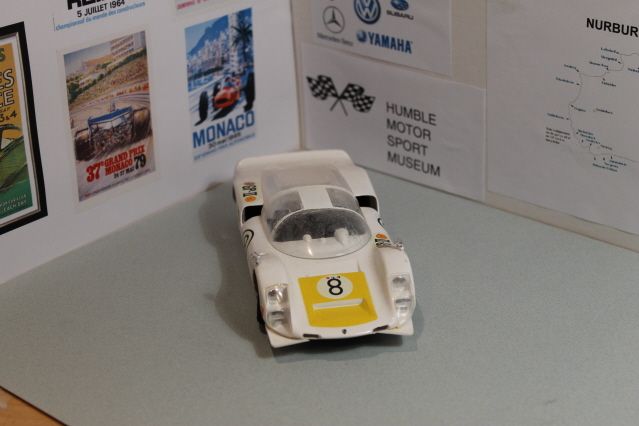
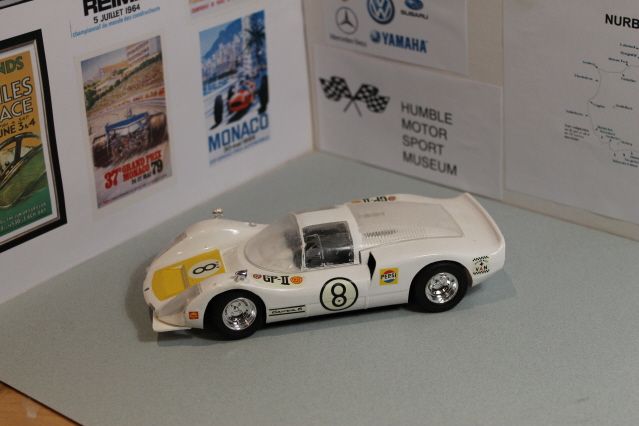
PORSCHE 906
The Porsche 906 or Carrera 6 was the last street-legal racing car from Porsche. 65 were produced in 1966. This allowed the model to be homologated for racing in the FIA's new
Group 4 Sports Car category although the type would also compete in modified form in the Group 6 Sports Prototype class.
A successor to the Porsche 904, and designed under Ferdinand Piëch's new regime at Porsche R&D, the 906 replaced the boxed structure of the 904 which used the fibreglass body for extra structural strength with a tubular space frame and unstressed fibreglass body. The fibreglass itself was laid up by hand, producing consistent results, instead of the uneven spraying technique used on the 904. The result was a car that weighed 580 kg (1,300 lb), approximately 250 lb (113 kg) lighter than the 904/6 (the 6-cylinder 904). The engine regularly fitted was the 901/20 6-cylinder lightweight racing engine with 220 hp and carburettors, although some examples that were raced by the factory team received fuel injected or 8-cylinder engines, especially in hill climbing events where Porsche competed with Ferrari Dinos for the European championship.
Unlike previous racing Porsches, the 906's body was tested in a wind tunnel, resulting in a top speed of 280 km/h (170 mph) at Le Mans, quite fast for a 2-liter engine car. It shows already a close resemblance to future Porsche racing cars. As in the Mercedes-Benz 300SL Gull-wing doors were fitted, and the engine at the rear was covered with a large Plexiglas cover.
At the 1966 24 Hours of Le Mans, the 906 placed 4-5-6-7 behind three Ford GT40
Mk IIs, outlasting all of the previously dominant V12 engined Ferrari’s. One of those cars is shown here wearing racing colours used when the car was subsequently sold in Japan.
Porsche 917K

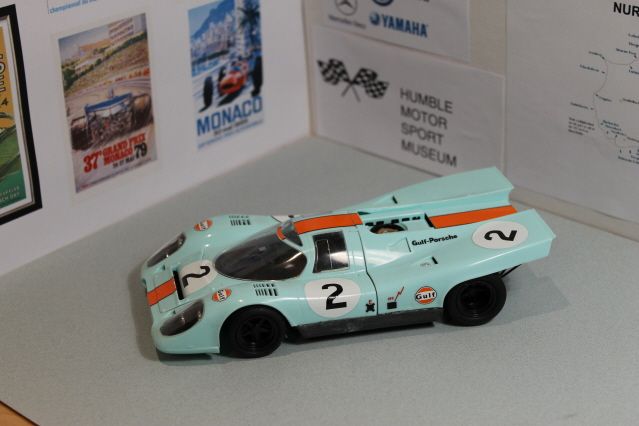
GULF PORSCHE 917K
The Porsche 917 is a racecar that gave Porsche its first overall wins at the 24 Hours of Le Mans 1970 and 1971 24 Hours of Le Mans. Powered by the Type 912 flat-12 engine of 4.5, 4.9, or 5 litres, the long-tailed version was capable of a 0-62 mph (100 km/h) time of 2.7 seconds and a top speed of over 240 mph (390 km/h). The car was built around a very light space frame chassis (42 kg (93 lb)) and powered by an air-cooled 4.5 litre Flat-12 with a 4 ratio transaxle. To keep the car compact despite the large engine the driver’s seat was so advanced to the front of the chassis that the feet of the drivers were in front of the front wheel axle. The car had remarkable technology: Porsche’s first 12-cylinder engine, and many components made of titanium, magnesium and exotic alloys that had been developed for lightweight "Bergspider" hill climb racers. Other methods of weight reduction were rather simple, such as making the gear shift knob out of balsa wood.
Disappointed by the poor results of the 917 in 1969, and facing new competition, Porsche concluded an agreement with John Wyer and his JWA Gulf Team, which became the official Porsche team, and also the official development partner. During tests at
Zeltweg, where the car had won its only race at that time, Wyer's engineer John Horsmann had the idea to increase down force at the expense of drag. A new wedge-shaped tail was moulded with aluminium sheets taped together. This new short tail gave the 917 much needed stability. The plastic engine intake cover had already been removed. The new version was called 917K (Kurzheck).
The domination of Gulf-Wyer and Martini Porsches in 1971 was overwhelming. The car seen here, Chassis number 917-013, was driven to victory in the 1971 Daytona 24 hour race by Pedro Rodriguez and Jackie Oliver.
Porsche 936
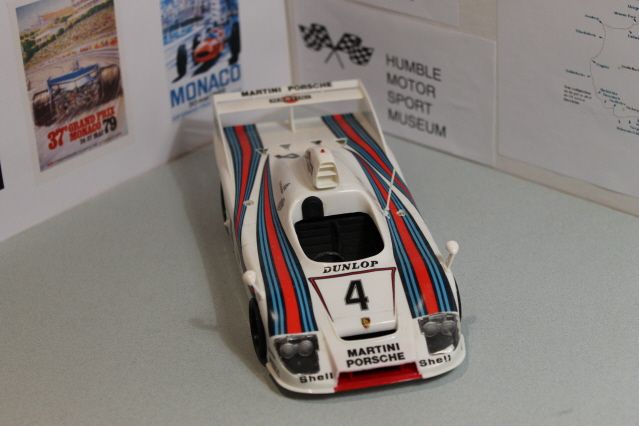
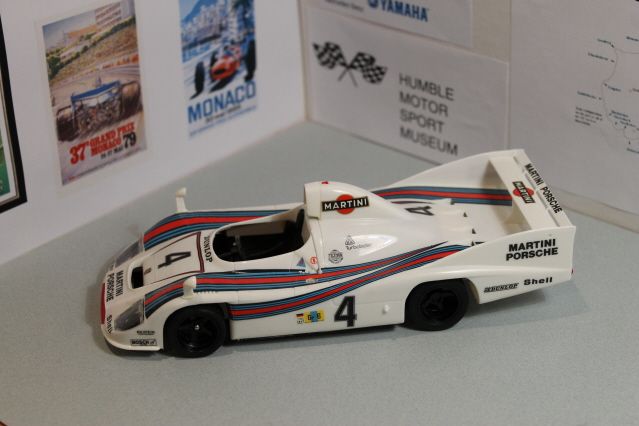
MARTINI RACING PORSCHE 936 TURBO
The Porsche 936 was a racing car introduced in 1976 by Porsche as a delayed successor to the Porsche 908, a three litre sports car prototype which was retired by the factory after 1971. Its name came from using a variant of the Porsche 930's turbocharged engine, as well as competing in Group 6 racing.
It was built to compete in the World Sports car Championship as well as at the 1976 24 Hours of Le Mans under the Group 6 formula, which it won both of. Chassis 002 with #20 won with Jacky Ickx and Gijs van Lennep won Le Mans, while the #18 chassis 001 of Reinhold Joest and Jürgen Barth had engine failure. It shared these victories with its production-based sibling, the Porsche 935 which won in Group 5. The open top, two seater spyder was powered by an air-cooled, two-valve 540 hp (403 kW) single-turbocharger flat-6 engine with 2140 cc, or the equivalent of 3000 cc including the 1.4 handicap factor. The space frame chassis was based on the 917, with many of the parts also came from the car. In the first outings, the Martini Racing car was still black, and the engine cover behind the roll bar was flat. The large hump and the air box above the engine were fitted onto the car later in the season. It is not for the air intake of the turbocharged engine, nor for cooling of the air-cooled engine itself, but instead mainly used for the intercooler.
From 1976 to 1981, the factory entered Porsche 936 won the 24 Hours of Le Mans three times, thus each of the three original chassis won once. The car on display here is the 1977 winner.
Porsche 956

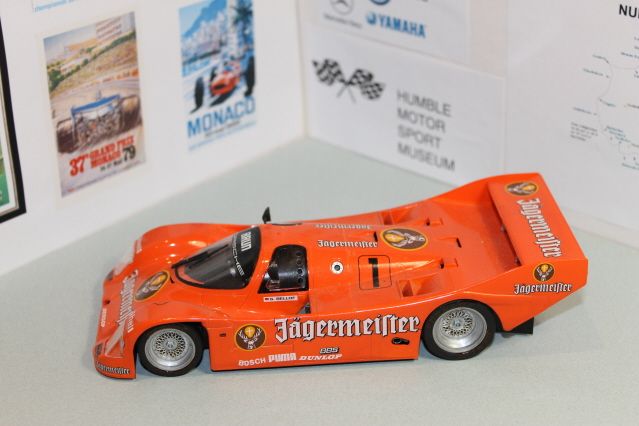
BRUN JAGERMEISTER PORSCHE 956C
The Porsche 956 was a Group C sports-prototype racing car built by Porsche in 1982 for the World Sportscar Championship . It was later upgraded to the 956B in 1984. Built to comply with the championship's new Group C regulations which were introduced in 1982, the car was a replacement for Porsche's successful model which competed in the previous Group 6 category of the World Championship. The project began in June 1981, and the first prototype chassis was completed on March 27 1982, in time for the beginning of the World Championship season. Jürgen Barth tested the first chassis at Porsche's private test track.
The 956 features a chassis made of an aluminium monocoque, a first for the company, helping to allow the car to meet the 800 kg (1,764 lb) weight minimum in Group C. The engine is the same as the one used in the Porsche 936, the Type-935 2.65 L turbocharged Flat-6, producing approximately 635 hp (474 kW). A new 5-speed gearbox was also designed for the 956. An improved chassis with better fuel efficiency from a Bosch Motronic electric system was developed for 1984, being termed the 956B. In total, twenty-eight 956s would be built by Porsche from 1982 to 1984, with an unofficial 29th chassis built from spare parts by Richard Lloyd Racing. The 956 would be officially replaced by the Porsche 962 in 1985, an evolution in the 956's design.
The car seen here has been painted to represent 956-116 as driven by Stefan Bellof (and Derek Bell) to victory at the Nurburgring 1000 km race during Bellof’s 1984 World Endurance Championship year. At the 1985 1000 km of Spa, Bellof (in 116) died after colliding with Jacky Ickx's newer 962.
Porsche 962C
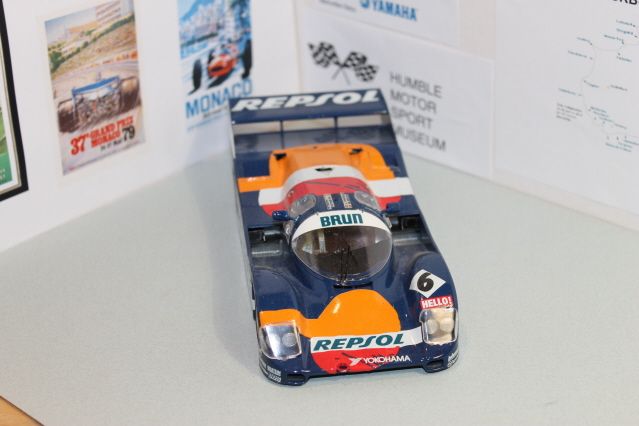
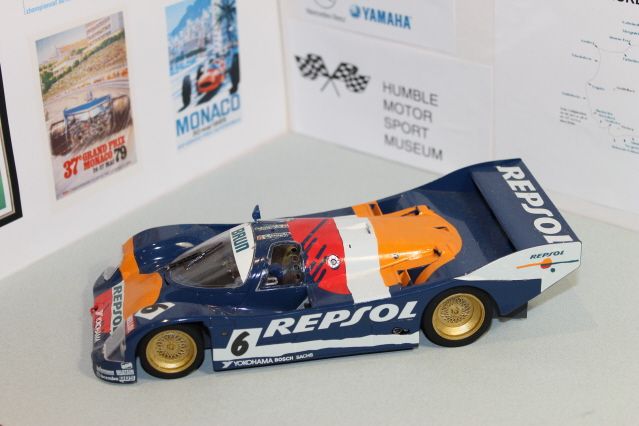
REPSOL BRUN RACING 962C
The Porsche 962 (also known as the 962C in its Group C form) was a sports-prototype racing car built by Porsche as a replacement for the 956 and designed mainly to comply with International_Motor_Sports_Association (IMSA) GT_Championship regulations, although it would later compete in the European Group C formula as the 956 had. The 962 was introduced at the end of 1984, from which it quickly became successful through private owners while having a remarkably long-lived career, with some examples still proving competitive into the mid-1990s.
When the Porsche 956 was developed in late 1981, the intention of Porsche was to run the car in both the World Sportscar Championship and the North American IMSA GTP Championship. However IMSA GTP regulations differed from Group C and subsequently the 956 was banned in the US series on safety grounds as the driver's feet were ahead of the front axle centre line. To make the 956 eligible under the IMSA regulations, Porsche extended the 956's wheelbase to make room for the pedal box.
In total, Porsche would produce 91 962s between 1984 and 1991. 16 were officially used by the factory team, while 75 were sold to customers. Some 956s were rebuilt as 962s, with two being previously written off and four others simply rebuilt. Three 962s that were badly damaged were also rebuilt had been given a new chassis number due to the extensive reconstruction. Due to the high demand for 962 parts, some aluminium chassis were built by Fabcar in the United States before being shipped to Germany for completion.
Among the most popular privately-built 962s was that from Kremer Racing, termed the 962CK6. 11 total were built, campaigned by Kremer and other teams. John Thompson designed a chassis for Brun Motorsport, eight of which were built and helped the team take second in the World Sportscar Championship in 1987. The vehicle shown here was driven by Pareja/Brun during the 1988/89 World Sportscar Series.
Mercedes SLR 300
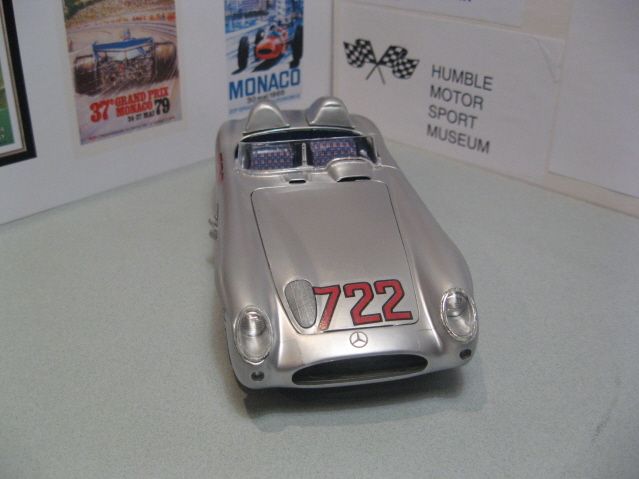
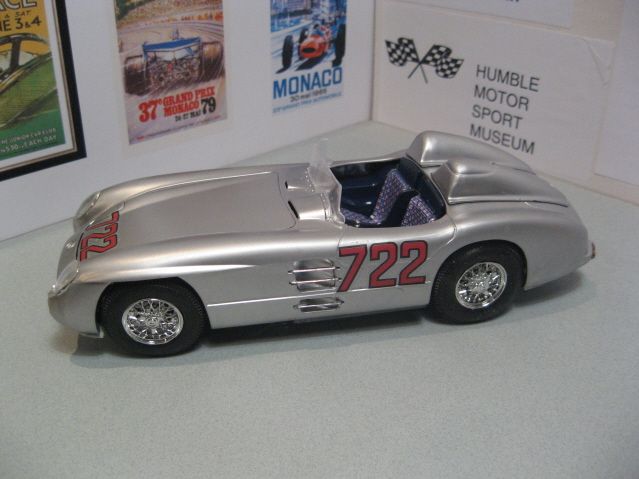
MERCEDES SLR 300
Why should 722 be the most important car in the world? In a word, ‘Moss’. Sir Stirling Moss to be precise, still the most universally admired racing driver ever; and Moss himself is always quick to point out that 722 is the most famous of all his steeds.
The reason for that are the awe in which the Mille Miglia road race was held back in the 1950s, and the way in which the heroic Moss and Denis Jenkinson victory in 1955 captured the public’s imagination. Here was England’s own racing hero beating the Italians at their own game. The car was configured specifically for the race, and because the Mille Miglia was a high-speed endurance race, run over a figure-eight shaped course on public roads between Brescia and Rome and then back to Brescia, Moss chose to take along, as navigator, his friend and motorsports journalist, Denis Jenkinson. The two of them ran over the course six times in the months before the race and took extensive course notes on an 18 foot-long roll of paper that “Jenks” un-rolled during the race and transmitted the information to Moss with a set of pre-arranged hand signals. They left Brescia at 7:22 AM (hence the car’s #722) and crossed the finish-line at 5:29’48” PM setting a record of 10 hr 7 min 48 sec that has not been bested. The team’s average speed was 159.65 km/hr (98 mph), a speed over 16 km/hr (10 mph) faster than the previous record. At times on the course, they reached speeds of over 280 km/hr (170+ mph).
As for the car itself, it rewrote the rule book. Based on the W196 Grand Prix car, there was little that was conventional. The straight eight engine used desmodromic valve gear (valves are mechanically opened and closed rather than simply using springs to close them, for improved precision) and fuel injection (a relatively new technology at the time). Drive was taken from the centre of the crankshaft via a gear, rather than from the end; massive drum brakes were fitted inboard and, for Le Mans, were supplemented by a clever air-brake arrangement; and the rear suspension was an unusual version of the swing axle, less prone to the ‘jacking up’ problems that typical swing axles suffer. The bodywork was produced in the ultra-lightweight Elektron magnesium alloy, also famously used on the 1935 Bugatti Aerolithe Paris show car.
Sadly it was a 300SLR that Pierre Levegh was driving when he careered into the crowd at the 1955 Le Mans, prompting Mercedes-Benz’s withdrawal not just from the race but also from international motor sport. Had the accident not occurred, an SLR would almost certainly have won or been podium-placed.
As for 722, after an active life it’s now in semi-retirement at the Humble Motor Racing Museum.
Sauber C9
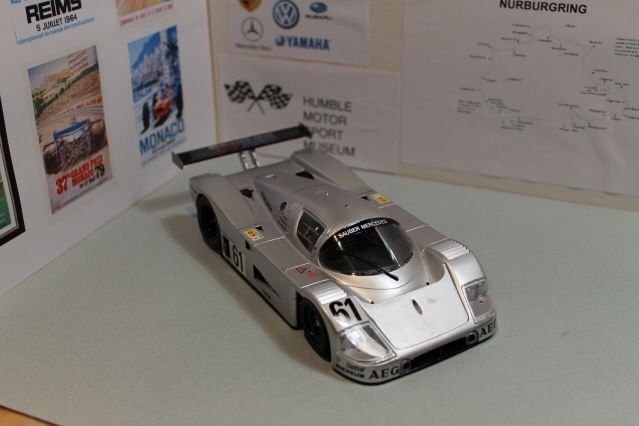
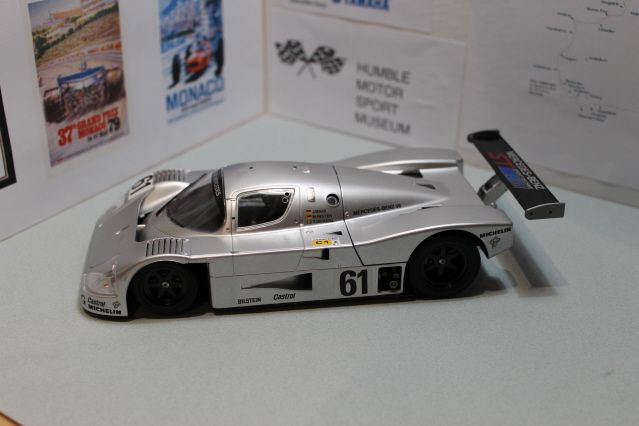
TEAM SAUBER MERCEDES C9
The Sauber C9 (later named the Mercedes-Benz C9 or Sauber Mercedes C9) was a
Group C prototype race car introduced in 1987 as a continuation of the partnership between Sauber as a constructor and Mercedes-Benz as an engine builder for the World Sportscar Championship. For its debut season in 1987, the cars were run by Kouros Racing, named after the fragrance brand of its sponsor, Yves Saint Laurent, although officially backed by Mercedes-Benz. The team managed a mere twelfth in the teams’ standings, scoring points in only a single round. For 1988, Kouros was dropped as a sponsor, forcing the team to be renamed Sauber Mercedes. As a result, Mercedes used AEG-Olympia for sponsor - AEG being owned by Daimler-Benz at the time. They managed to finish second in the championship behind Silk Cut Jaguar with five wins for the season. Unfortunately at the 24 Hours of Le Mans, the team suffered an embarrassing setback when they were forced to withdraw due to concern over their Michelin tires.
Finally, in 1989, the car was able to achieve great success. Besides replacing the black colour scheme for its national plain silver scheme, reducing AEG as a minor sponsor, the older Mercedes M117 5.0L turbocharged V8 engine was upgraded to the M119, which replaced steel heads with new aluminium. The C9 was able to win all but one race in the
1989 season, including the 24 Hours of Le Mans. During qualifying for Le Mans, the C9 recorded a speed of 247mph (398km/h) on the Mulsanne Straight, a record. Mercedes driver Jean-Louis Schlesser would end up taking the driver's championship that season.
The car on display is the C9 driven to victory at the 1989 Le Mans 24 Hour race by Jochen Mass, Manuel Reuter and Stanley Dickens.




Porsche 906:


PORSCHE 906
The Porsche 906 or Carrera 6 was the last street-legal racing car from Porsche. 65 were produced in 1966. This allowed the model to be homologated for racing in the FIA's new
Group 4 Sports Car category although the type would also compete in modified form in the Group 6 Sports Prototype class.
A successor to the Porsche 904, and designed under Ferdinand Piëch's new regime at Porsche R&D, the 906 replaced the boxed structure of the 904 which used the fibreglass body for extra structural strength with a tubular space frame and unstressed fibreglass body. The fibreglass itself was laid up by hand, producing consistent results, instead of the uneven spraying technique used on the 904. The result was a car that weighed 580 kg (1,300 lb), approximately 250 lb (113 kg) lighter than the 904/6 (the 6-cylinder 904). The engine regularly fitted was the 901/20 6-cylinder lightweight racing engine with 220 hp and carburettors, although some examples that were raced by the factory team received fuel injected or 8-cylinder engines, especially in hill climbing events where Porsche competed with Ferrari Dinos for the European championship.
Unlike previous racing Porsches, the 906's body was tested in a wind tunnel, resulting in a top speed of 280 km/h (170 mph) at Le Mans, quite fast for a 2-liter engine car. It shows already a close resemblance to future Porsche racing cars. As in the Mercedes-Benz 300SL Gull-wing doors were fitted, and the engine at the rear was covered with a large Plexiglas cover.
At the 1966 24 Hours of Le Mans, the 906 placed 4-5-6-7 behind three Ford GT40
Mk IIs, outlasting all of the previously dominant V12 engined Ferrari’s. One of those cars is shown here wearing racing colours used when the car was subsequently sold in Japan.
Porsche 917K


GULF PORSCHE 917K
The Porsche 917 is a racecar that gave Porsche its first overall wins at the 24 Hours of Le Mans 1970 and 1971 24 Hours of Le Mans. Powered by the Type 912 flat-12 engine of 4.5, 4.9, or 5 litres, the long-tailed version was capable of a 0-62 mph (100 km/h) time of 2.7 seconds and a top speed of over 240 mph (390 km/h). The car was built around a very light space frame chassis (42 kg (93 lb)) and powered by an air-cooled 4.5 litre Flat-12 with a 4 ratio transaxle. To keep the car compact despite the large engine the driver’s seat was so advanced to the front of the chassis that the feet of the drivers were in front of the front wheel axle. The car had remarkable technology: Porsche’s first 12-cylinder engine, and many components made of titanium, magnesium and exotic alloys that had been developed for lightweight "Bergspider" hill climb racers. Other methods of weight reduction were rather simple, such as making the gear shift knob out of balsa wood.
Disappointed by the poor results of the 917 in 1969, and facing new competition, Porsche concluded an agreement with John Wyer and his JWA Gulf Team, which became the official Porsche team, and also the official development partner. During tests at
Zeltweg, where the car had won its only race at that time, Wyer's engineer John Horsmann had the idea to increase down force at the expense of drag. A new wedge-shaped tail was moulded with aluminium sheets taped together. This new short tail gave the 917 much needed stability. The plastic engine intake cover had already been removed. The new version was called 917K (Kurzheck).
The domination of Gulf-Wyer and Martini Porsches in 1971 was overwhelming. The car seen here, Chassis number 917-013, was driven to victory in the 1971 Daytona 24 hour race by Pedro Rodriguez and Jackie Oliver.
Porsche 936


MARTINI RACING PORSCHE 936 TURBO
The Porsche 936 was a racing car introduced in 1976 by Porsche as a delayed successor to the Porsche 908, a three litre sports car prototype which was retired by the factory after 1971. Its name came from using a variant of the Porsche 930's turbocharged engine, as well as competing in Group 6 racing.
It was built to compete in the World Sports car Championship as well as at the 1976 24 Hours of Le Mans under the Group 6 formula, which it won both of. Chassis 002 with #20 won with Jacky Ickx and Gijs van Lennep won Le Mans, while the #18 chassis 001 of Reinhold Joest and Jürgen Barth had engine failure. It shared these victories with its production-based sibling, the Porsche 935 which won in Group 5. The open top, two seater spyder was powered by an air-cooled, two-valve 540 hp (403 kW) single-turbocharger flat-6 engine with 2140 cc, or the equivalent of 3000 cc including the 1.4 handicap factor. The space frame chassis was based on the 917, with many of the parts also came from the car. In the first outings, the Martini Racing car was still black, and the engine cover behind the roll bar was flat. The large hump and the air box above the engine were fitted onto the car later in the season. It is not for the air intake of the turbocharged engine, nor for cooling of the air-cooled engine itself, but instead mainly used for the intercooler.
From 1976 to 1981, the factory entered Porsche 936 won the 24 Hours of Le Mans three times, thus each of the three original chassis won once. The car on display here is the 1977 winner.
Porsche 956


BRUN JAGERMEISTER PORSCHE 956C
The Porsche 956 was a Group C sports-prototype racing car built by Porsche in 1982 for the World Sportscar Championship . It was later upgraded to the 956B in 1984. Built to comply with the championship's new Group C regulations which were introduced in 1982, the car was a replacement for Porsche's successful model which competed in the previous Group 6 category of the World Championship. The project began in June 1981, and the first prototype chassis was completed on March 27 1982, in time for the beginning of the World Championship season. Jürgen Barth tested the first chassis at Porsche's private test track.
The 956 features a chassis made of an aluminium monocoque, a first for the company, helping to allow the car to meet the 800 kg (1,764 lb) weight minimum in Group C. The engine is the same as the one used in the Porsche 936, the Type-935 2.65 L turbocharged Flat-6, producing approximately 635 hp (474 kW). A new 5-speed gearbox was also designed for the 956. An improved chassis with better fuel efficiency from a Bosch Motronic electric system was developed for 1984, being termed the 956B. In total, twenty-eight 956s would be built by Porsche from 1982 to 1984, with an unofficial 29th chassis built from spare parts by Richard Lloyd Racing. The 956 would be officially replaced by the Porsche 962 in 1985, an evolution in the 956's design.
The car seen here has been painted to represent 956-116 as driven by Stefan Bellof (and Derek Bell) to victory at the Nurburgring 1000 km race during Bellof’s 1984 World Endurance Championship year. At the 1985 1000 km of Spa, Bellof (in 116) died after colliding with Jacky Ickx's newer 962.
Porsche 962C


REPSOL BRUN RACING 962C
The Porsche 962 (also known as the 962C in its Group C form) was a sports-prototype racing car built by Porsche as a replacement for the 956 and designed mainly to comply with International_Motor_Sports_Association (IMSA) GT_Championship regulations, although it would later compete in the European Group C formula as the 956 had. The 962 was introduced at the end of 1984, from which it quickly became successful through private owners while having a remarkably long-lived career, with some examples still proving competitive into the mid-1990s.
When the Porsche 956 was developed in late 1981, the intention of Porsche was to run the car in both the World Sportscar Championship and the North American IMSA GTP Championship. However IMSA GTP regulations differed from Group C and subsequently the 956 was banned in the US series on safety grounds as the driver's feet were ahead of the front axle centre line. To make the 956 eligible under the IMSA regulations, Porsche extended the 956's wheelbase to make room for the pedal box.
In total, Porsche would produce 91 962s between 1984 and 1991. 16 were officially used by the factory team, while 75 were sold to customers. Some 956s were rebuilt as 962s, with two being previously written off and four others simply rebuilt. Three 962s that were badly damaged were also rebuilt had been given a new chassis number due to the extensive reconstruction. Due to the high demand for 962 parts, some aluminium chassis were built by Fabcar in the United States before being shipped to Germany for completion.
Among the most popular privately-built 962s was that from Kremer Racing, termed the 962CK6. 11 total were built, campaigned by Kremer and other teams. John Thompson designed a chassis for Brun Motorsport, eight of which were built and helped the team take second in the World Sportscar Championship in 1987. The vehicle shown here was driven by Pareja/Brun during the 1988/89 World Sportscar Series.
Mercedes SLR 300


MERCEDES SLR 300
Why should 722 be the most important car in the world? In a word, ‘Moss’. Sir Stirling Moss to be precise, still the most universally admired racing driver ever; and Moss himself is always quick to point out that 722 is the most famous of all his steeds.
The reason for that are the awe in which the Mille Miglia road race was held back in the 1950s, and the way in which the heroic Moss and Denis Jenkinson victory in 1955 captured the public’s imagination. Here was England’s own racing hero beating the Italians at their own game. The car was configured specifically for the race, and because the Mille Miglia was a high-speed endurance race, run over a figure-eight shaped course on public roads between Brescia and Rome and then back to Brescia, Moss chose to take along, as navigator, his friend and motorsports journalist, Denis Jenkinson. The two of them ran over the course six times in the months before the race and took extensive course notes on an 18 foot-long roll of paper that “Jenks” un-rolled during the race and transmitted the information to Moss with a set of pre-arranged hand signals. They left Brescia at 7:22 AM (hence the car’s #722) and crossed the finish-line at 5:29’48” PM setting a record of 10 hr 7 min 48 sec that has not been bested. The team’s average speed was 159.65 km/hr (98 mph), a speed over 16 km/hr (10 mph) faster than the previous record. At times on the course, they reached speeds of over 280 km/hr (170+ mph).
As for the car itself, it rewrote the rule book. Based on the W196 Grand Prix car, there was little that was conventional. The straight eight engine used desmodromic valve gear (valves are mechanically opened and closed rather than simply using springs to close them, for improved precision) and fuel injection (a relatively new technology at the time). Drive was taken from the centre of the crankshaft via a gear, rather than from the end; massive drum brakes were fitted inboard and, for Le Mans, were supplemented by a clever air-brake arrangement; and the rear suspension was an unusual version of the swing axle, less prone to the ‘jacking up’ problems that typical swing axles suffer. The bodywork was produced in the ultra-lightweight Elektron magnesium alloy, also famously used on the 1935 Bugatti Aerolithe Paris show car.
Sadly it was a 300SLR that Pierre Levegh was driving when he careered into the crowd at the 1955 Le Mans, prompting Mercedes-Benz’s withdrawal not just from the race but also from international motor sport. Had the accident not occurred, an SLR would almost certainly have won or been podium-placed.
As for 722, after an active life it’s now in semi-retirement at the Humble Motor Racing Museum.
Sauber C9


TEAM SAUBER MERCEDES C9
The Sauber C9 (later named the Mercedes-Benz C9 or Sauber Mercedes C9) was a
Group C prototype race car introduced in 1987 as a continuation of the partnership between Sauber as a constructor and Mercedes-Benz as an engine builder for the World Sportscar Championship. For its debut season in 1987, the cars were run by Kouros Racing, named after the fragrance brand of its sponsor, Yves Saint Laurent, although officially backed by Mercedes-Benz. The team managed a mere twelfth in the teams’ standings, scoring points in only a single round. For 1988, Kouros was dropped as a sponsor, forcing the team to be renamed Sauber Mercedes. As a result, Mercedes used AEG-Olympia for sponsor - AEG being owned by Daimler-Benz at the time. They managed to finish second in the championship behind Silk Cut Jaguar with five wins for the season. Unfortunately at the 24 Hours of Le Mans, the team suffered an embarrassing setback when they were forced to withdraw due to concern over their Michelin tires.
Finally, in 1989, the car was able to achieve great success. Besides replacing the black colour scheme for its national plain silver scheme, reducing AEG as a minor sponsor, the older Mercedes M117 5.0L turbocharged V8 engine was upgraded to the M119, which replaced steel heads with new aluminium. The C9 was able to win all but one race in the
1989 season, including the 24 Hours of Le Mans. During qualifying for Le Mans, the C9 recorded a speed of 247mph (398km/h) on the Mulsanne Straight, a record. Mercedes driver Jean-Louis Schlesser would end up taking the driver's championship that season.
The car on display is the C9 driven to victory at the 1989 Le Mans 24 Hour race by Jochen Mass, Manuel Reuter and Stanley Dickens.
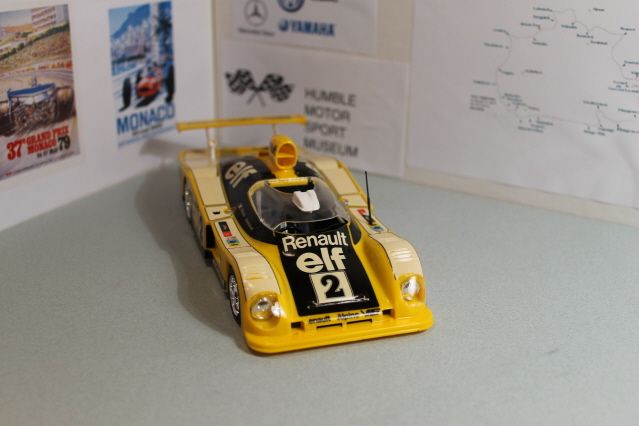
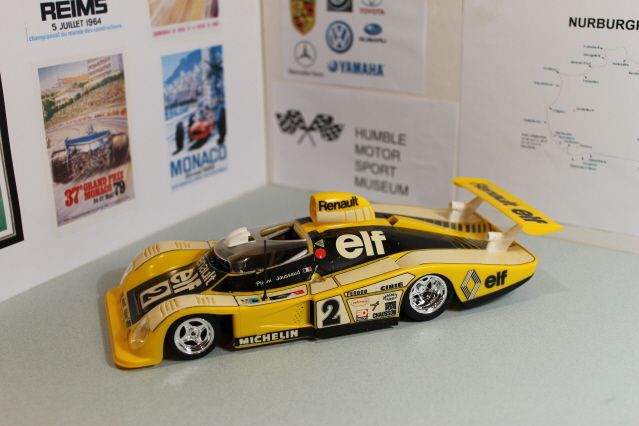
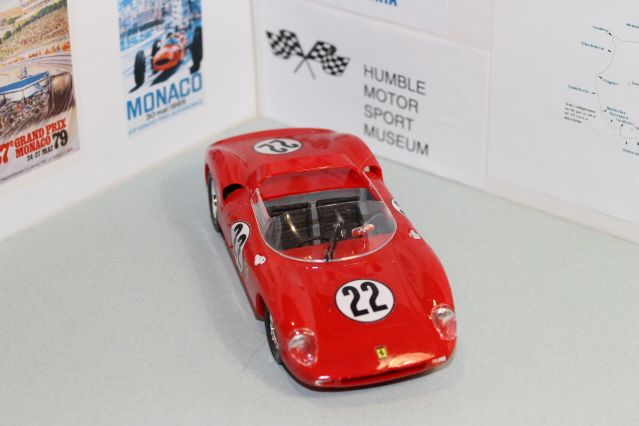


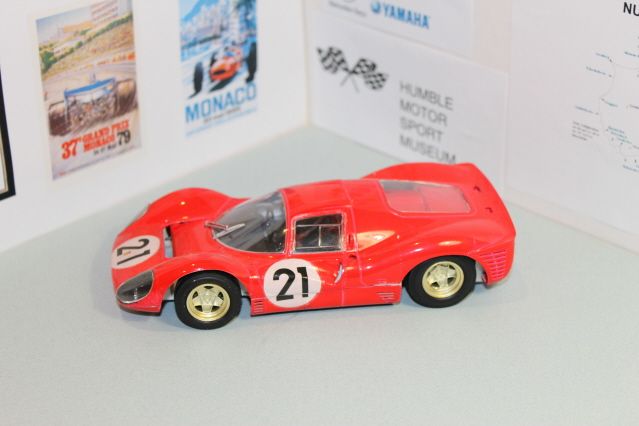



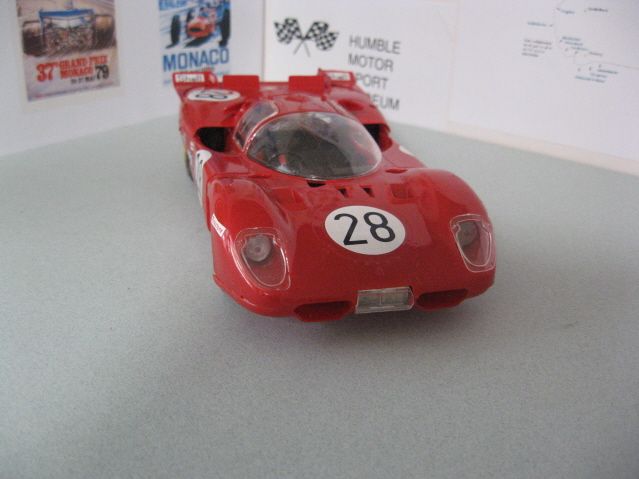
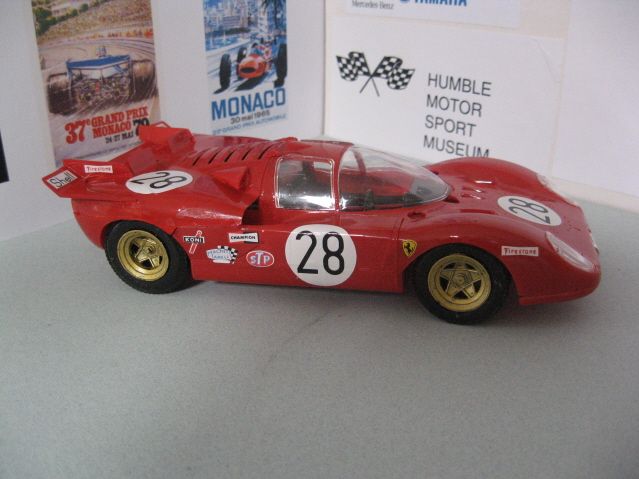
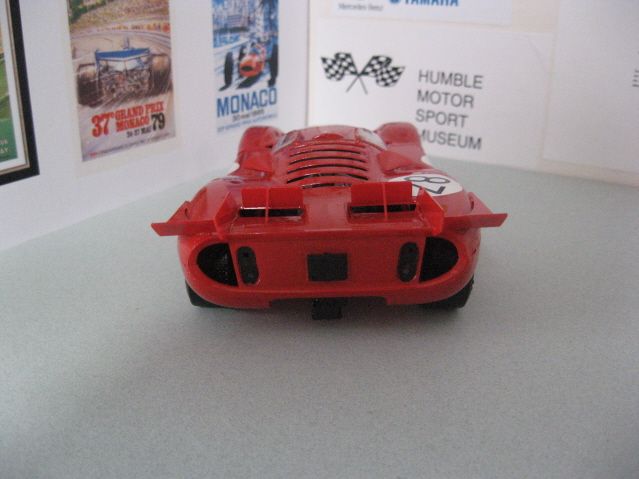


 ?
?
